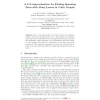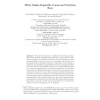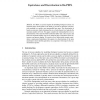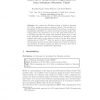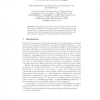WAOA
2007
Springer
13 years 10 months ago
2007
Springer
For a connected graph G, let L(G) denote the maximum number of leaves in a spanning tree in G. The problem of computing L(G) is known to be NP-hard even for cubic graphs. We improv...
COCOON
2007
Springer
13 years 10 months ago
2007
Springer
We investigate the maximum number of simple cycles and the maximum number of Hamiltonian cycles in a planar graph G with n vertices. Using the transfer matrix method we construct a...
IWPEC
2009
Springer
13 years 11 months ago
2009
Springer
We study the Equitable Connected Partition problem, which is the problem of partitioning a graph into a given number of partitions, such that each partition induces a connected sub...
CMSB
2009
Springer
13 years 11 months ago
2009
Springer
Bio-PEPA is a process algebra for modelling biological systems. An important aspect of Bio-PEPA is the ability it provides to discretise concentrations resulting in a smaller, more...
WG
2009
Springer
13 years 11 months ago
2009
Springer
We consider the NP-hard problem of finding a spanning tree with a maximum number of internal vertices. This problem is a generalization of the famous Hamiltonian Path problem. Our...
LATA
2009
Springer
13 years 11 months ago
2009
Springer
We present a new series of run-rich strings, and give a new lower bound 0.94457567 of the maximum number of runs in a string. We also introduce the general conjecture about a asymp...
DCC
2003
IEEE
14 years 4 months ago
2003
IEEE
We show that 40 is the maximum number of points of a cap in AG(4, 4). Up to semi-linear transformations there is only one such 40-cap. Its group of automorphisms is a semidirect p...
